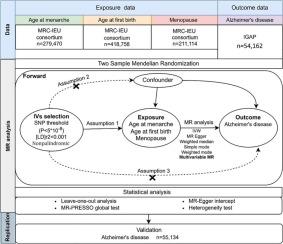生殖里程碑与阿尔茨海默病风险之间的关系:一项孟德尔随机研究。
IF 2.6
4区 医学
Q3 NEUROSCIENCES
引用次数: 0
摘要
背景:阿尔茨海默病(AD)是一种常见的神经退行性疾病。先前的研究表明女性生育史与AD风险之间存在关联,但这些关系的因果性质尚不清楚。本研究旨在通过孟德尔随机化(MR)和多变量MR分析,探讨女性关键生殖里程碑(月经初潮年龄、第一胎年龄和更年期)与AD风险之间的因果关系。方法:使用大规模全基因组关联研究的汇总数据进行双样本MR和多变量MR分析。与女性生殖里程碑相关的遗传变异作为工具变量。复制阶段数据由医学研究理事会综合流行病学单位联盟提供。选择核心单核苷酸多态性来检查初潮年龄、初产年龄和更年期对AD风险的影响。方差反加权法是主要的分析方法,因果关系评估使用MR-Egger回归和加权中位数估计。采用Cochran’s Q检验和MR-PRESSO全局检验进行敏感性分析和多效性评估。本研究遵循STROBE-MR检查表报告MR研究。结果:先生分析显示,基因预测初潮的年龄和年龄早些时候生育的可能与风险增加相关的广告(或 = 0.92,95 % CI: 0.85 - -0.99, p = 0.022;或 = 0.90,95%置信区间CI: 0.84 - -0.96, p = 0.002,分别)。相反,基因预测更年期与AD风险增加相关(OR = 2.55,95 % CI: 1.06-6.14, p = 0.036)。结论:本MR研究提供的证据表明,基因预测的初潮年龄、初产年龄和绝经年龄与AD风险显著相关,且相互独立。这些发现强调了女性生殖里程碑在阿尔茨海默病发病机制中的潜在作用。本文章由计算机程序翻译,如有差异,请以英文原文为准。

Associations between reproductive milestones and Alzheimer’s disease risk: a Mendelian randomization study
Background
Alzheimer’s disease (AD) is a prevalent neurodegenerative disorder. Previous studies have suggested associations between female reproductive history and AD risk, but the causal nature of these relationships remains unclear. This study aimed to investigate the causal relationships between key female reproductive milestones (age at menarche, age at first birth, and menopause) and AD risk using Mendelian randomization (MR) and multivariate MR analysis.
Methods
Two-sample MR and multivariate MR analyses were conducted using pooled data from large-scale genome-wide association studies. Genetic variants associated with female reproductive milestones served as instrumental variables. Replication phase data were provided by the Medical Research Council Integrative Epidemiology Unit consortium. Core single-nucleotide polymorphisms were selected to examine the effects of age at menarche, age at first birth, and menopause on AD risk. The inverse variance weighting method was the primary analytical approach, with causality assessed using MR-Egger regression and weighted median estimation. Sensitivity analyses and pleiotropy assessments were performed using Cochran’s Q test and the MR-PRESSO global test. This study followed the STROBE-MR checklist for reporting MR studies.
Results
MR analysis revealed that genetically predicted earlier age at menarche and age at first birth are potentially associated with increased risk of AD (OR = 0.92, 95 % CI: 0.85–0.99, p = 0.022; OR = 0.90, 95 % CI: 0.84–0.96, p = 0.002, respectively). Conversely, genetically predicted menopause was associated with increased AD risk (OR = 2.55, 95 % CI: 1.06–6.14, p = 0.036).
Conclusion
This MR study provides evidence suggesting that genetically predicted age at menarche, age at first birth, and menopause are significantly associated with AD risk, operating independently of each other. These findings highlight the potential role of female reproductive milestones in AD pathogenesis.
求助全文
通过发布文献求助,成功后即可免费获取论文全文。
去求助
来源期刊

Brain Research
医学-神经科学
CiteScore
5.90
自引率
3.40%
发文量
268
审稿时长
47 days
期刊介绍:
An international multidisciplinary journal devoted to fundamental research in the brain sciences.
Brain Research publishes papers reporting interdisciplinary investigations of nervous system structure and function that are of general interest to the international community of neuroscientists. As is evident from the journals name, its scope is broad, ranging from cellular and molecular studies through systems neuroscience, cognition and disease. Invited reviews are also published; suggestions for and inquiries about potential reviews are welcomed.
With the appearance of the final issue of the 2011 subscription, Vol. 67/1-2 (24 June 2011), Brain Research Reviews has ceased publication as a distinct journal separate from Brain Research. Review articles accepted for Brain Research are now published in that journal.
 求助内容:
求助内容: 应助结果提醒方式:
应助结果提醒方式:


